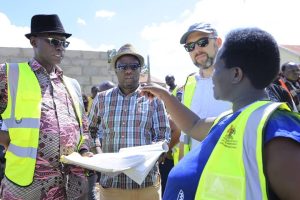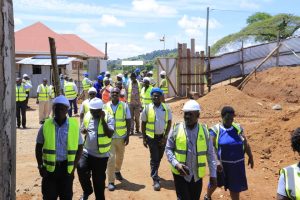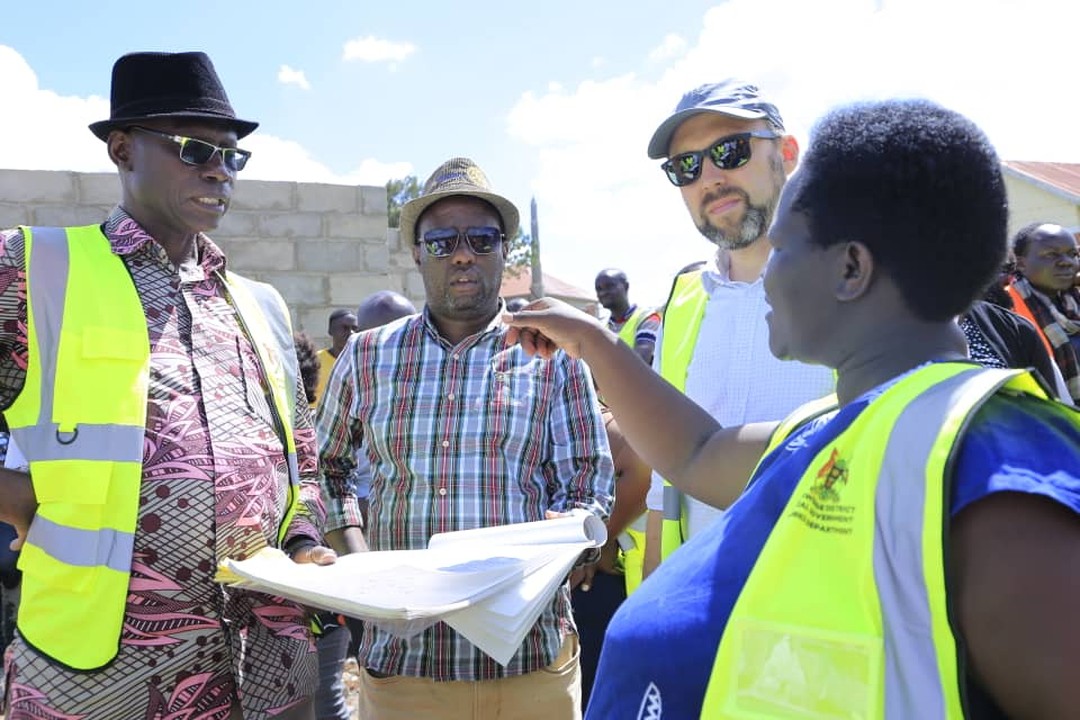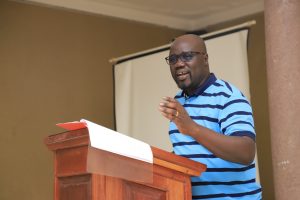On April 27th 2023, officials from the World Bank, the funder of the Government’s USMID program, visited Kamwenge District to assess the progress of ongoing projects. The visit was welcomed by the district CAO, Mr. Turyahebwa Hanny, who expressed gratitude to the Government of Uganda, World Bank and the Ministry of Lands, housing and urban development for the support to the district and the job well done so far.
 During the visit, Joseph Walter Pade – The Commissioner Urban Development, in the Ministry of Lands, highlighted the six physical infrastructure projects being undertaken in Kamwenge; construction of 3 gravel roads (19.7kms) Bwitankanja Nsonosa Road (5.6kms), Burambira-Mikamba Road (6.7kms) and Mutwe Kyamwera Road, resource centre and market shed at Nkoma sub-county, a playground stadium, Taxi park and another Resource centre at Nkoma Katalyebwa Town Council (already completed).
During the visit, Joseph Walter Pade – The Commissioner Urban Development, in the Ministry of Lands, highlighted the six physical infrastructure projects being undertaken in Kamwenge; construction of 3 gravel roads (19.7kms) Bwitankanja Nsonosa Road (5.6kms), Burambira-Mikamba Road (6.7kms) and Mutwe Kyamwera Road, resource centre and market shed at Nkoma sub-county, a playground stadium, Taxi park and another Resource centre at Nkoma Katalyebwa Town Council (already completed).
The purpose of the visit was to inspect the civil works projects in Kamwenge District, assess the performance of the physical planning sub-component and the systematic land adjudication project. The World Bank’s support to the District Local Governments hosting large numbers of refugees through the USMID- Additional Financing Programme has helped Kamwenge, which currently hosts 86114 refugees, make significant progress in infrastructure development.
In the support to the refugee hosting districts sub-component, the funding goes to three areas; (a) physical planning, (b) land tenure (systematic land adjudication and certification) and (c) infrastructure investments.
 Apart from Kamwenge, the other beneficiary Local Governments are: Lamwo, Moyo, Adjumani, Arua, Terego, Madi-Okollo, Yumbe, Obongi, Kiryandongo, and Isingiro, all hosting refugees from South Sudan, the Democratic Republic of Congo, Burundi and Somalia among others.
Apart from Kamwenge, the other beneficiary Local Governments are: Lamwo, Moyo, Adjumani, Arua, Terego, Madi-Okollo, Yumbe, Obongi, Kiryandongo, and Isingiro, all hosting refugees from South Sudan, the Democratic Republic of Congo, Burundi and Somalia among others.
According to the March 2022 statistics from the Office of the Prime Minister, in the Department of Refugees, the exact population of refugees was 1,582,076, distributed across more than 11 USMID-supported communities. Of the numbers, 80% are said to be women and children, 3% elderly, while the remaining 24% account for youth.
In Kamwenge, the visit witnessed testimonies of many excited and seemingly satisfied community members, some of who have donated their private land to the districts for the cause of constructing resource centres, market sheds, and playgrounds. This kind of hospitality has earned them numerous development projects because they have opened their doors to the refugees.
One of the roads being constructed is the 6.7kms Burambira-Mikamba Roadand is contracted by M/S SCOL civil construction company Ltd. Visiting the road, the Kamwenge District LC5 Chairperson- Joseph Kalungi, was upbeat on the already registered benefits of the road even before completion has improved accessibility for locals.
 “Before work commenced, we endeavoured to get the locals’ consent. I am pleased to inform you that the community is so happy with Burambira Road – At this level, those who had accessibility challenges say it’s a thing of the past,” said Kalungi.
“Before work commenced, we endeavoured to get the locals’ consent. I am pleased to inform you that the community is so happy with Burambira Road – At this level, those who had accessibility challenges say it’s a thing of the past,” said Kalungi.
The road has also facilitated trade, and Mr. Byarugaba Isaiah- RDC Kamwenge District, added that “thanks to this road, we are now receiving trucks from Rwanda and DRC coming here to buy agricultural products. We believe the construction of this road will bring easy access for the traders in the area.”
Benjamin Christopher Reese- World Bank’s Senior Operations Officer, said, “We are proud of the progress made so far. We believe these projects will make a real difference in the locals’ lives and facilitate trade in the area. We will continue to work closely with the district government and the Ministry of Lands, Housing, and Urban Development to ensure the program’s success.”
The physical Infrastructure projects in refugee hosting districts aim to strengthen interaction between the hosts and the refugees, and enhance a peaceful co-existence amongst the host communities and refugees. Resource centres, community hall buildings, stadiums & playgrounds, markets & leisure parks all promote sports, art and culture, further enhancing social cohesion between the refugees and their hosts.
According to the District Community Development Officer, Ms. Miyigira Harriet said, “The two Resource Centres- one in Nkoma Sub-County and another at Nkoma Katalyebwa Town Council under completion will serve the general community with priority given to persons living with disabilities. These will be used to host skills trainings like vocational training in various fields such as agriculture, tailoring, carpentry, welding, and bricklaying. They will also be used for health promotion events, community meetings, education and youth mentorship activities.”
Regarding the progress, Stephen John Ajalu, Senior Urban Development Specialist and Task Team Leader, said, “We are very pleased with the progress of the USMID program in Kamwenge District. The physical infrastructure projects are intended to enhance social cohesion between the refugees and their hosts, while also promoting sports, art, and culture. Also, we appreciate the hospitality of the community members who have donated their private land for the cause, and in case a chance for additional services comes- we will continue to support the district’s infrastructure development to make a positive impact on the lives of the refugees and the host communities.”
Uganda started opening its doors to refugees in around 1958 and the country is currently the largest host of refugees in Africa and the third-largest host in the world, with over 1.5 million refugees. Refugees settled in Northern Uganda, predominantly in the West Nile sub-region, now constitute more than one-third of the district population.
Uganda has a progressive refugee regime in the world, where refugees are guaranteed the right to work, establish a business, move freely within the country, access social services, own property and obtain documentation among so many other positives. It empowers refugees to become economically self-reliant while granting them the same rights that citizens enjoy.
This has ultimately turned the hosting rural communities into settlements with urban features, an arrangement that puts enormous pressure on the Local Government’s and host communities’ ability to provide adequate infrastructure and services to this rapidly increased population.
It is because of this background that the Government, after the successful implementation of the first phase of the Uganda Support to Municipal Infrastructure Development (USMID) Program, received additional financing to the tune of US$ 360 million from the World Bank/IDA to implement the second phase of the Program (USMID Additional Financing-USMID-AF) for 5years which started in the fiscal year 2018/19 and is to end this year, 2023- and allocated part of the money (60M) to the support to refugee hosting districts subcomponent, to enable them to improve in physical planning, land tenure security, and infrastructure investments to benefit both refugees and host communities.
The progress made in Kamwenge District is a testament to the positive impact that partnerships between governments and development partners can have on communities. The infrastructure developments being undertaken in Kamwenge will not only improve the lives of the locals but also promote economic growth in the area.



